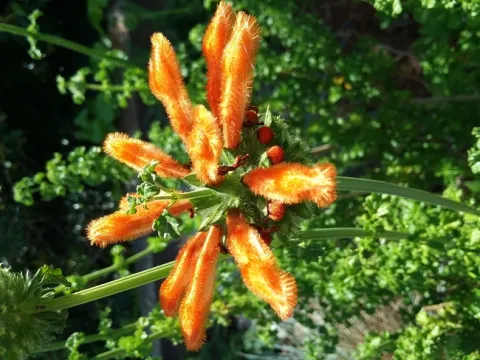
Leonotis leonurus
By Polly Nelson UCCE Master Gardener
Lion's Tail, Lamiaceae (Labiatae)
Planting Zone: Sunset 8-24
Size: 4-6 feet tall
Bloom season: Erect orange flowers from late spring through fall.
Exposure: Full sun, light shade.
Pruning needs: Depends on how large a plant you want in your garden; without pruning they can get really big very quickly.
Water needs: Low, once established.
Narrative: Native to South Africa, this plant is deer-resistant and attracts birds, butterflies and hummingbirds. It is bothered by few pests, but keep an eye out for spider mites or white flies. It can be propagated from seeds started indoors in winter, or greenwood cuttings in late spring or summer. Leonotis leonurus is an annual in cold winter temperatures; a perennial in areas with mild temperatures. A member of the mint family, the plant has green leaves that are 2-5 inches long and slightly aromatic when bruised. The tubular, deep-orange, showy flowers grow in tiered whorls around the top half of long, upright stems, giving rise to the plant's nickname “lion's tail”. Blossoms appear on new wood, so pruning is beneficial not only for shaping of the plant, but also to encourage more blossoms. In frost-prone areas, prune early in the spring after danger of frost, as low as 6 inches from the ground. Using sterilized garden clippers, make angled cuts on the branch where it joins the main stem. Pruning old, dead branches can be done anytime, but wait until after the blooming season (late fall) in more temperate areas. Up to one-third of the bush can be removed, opening it up to more light in the center and improving air circulation. Once flowers have faded, deadhead back to ground level. Doing so makes the plant think it has not produced enough blooms for seed and reproduction, so it responds by pushing new blooms. Leonotis leonurus can be planted in many types of gardens, such as Mediterranean, coastal, and informal cottage. It can be massed with a variety of plants, including lavender and salvias, used in beds and borders, in front of walls, or grown in containers on patios in full sun.

